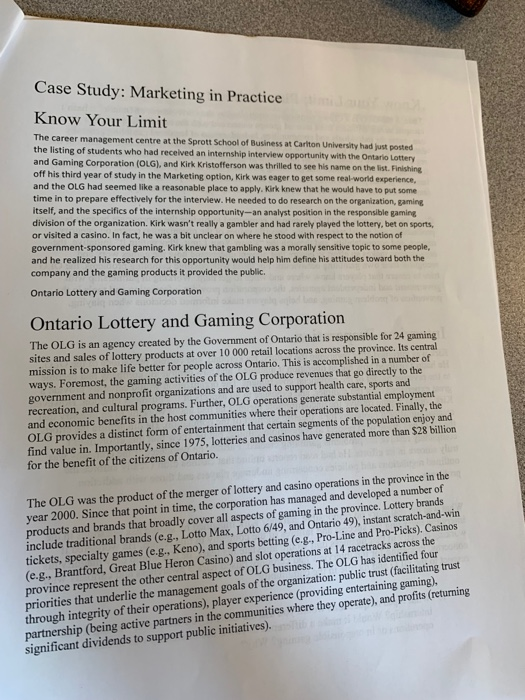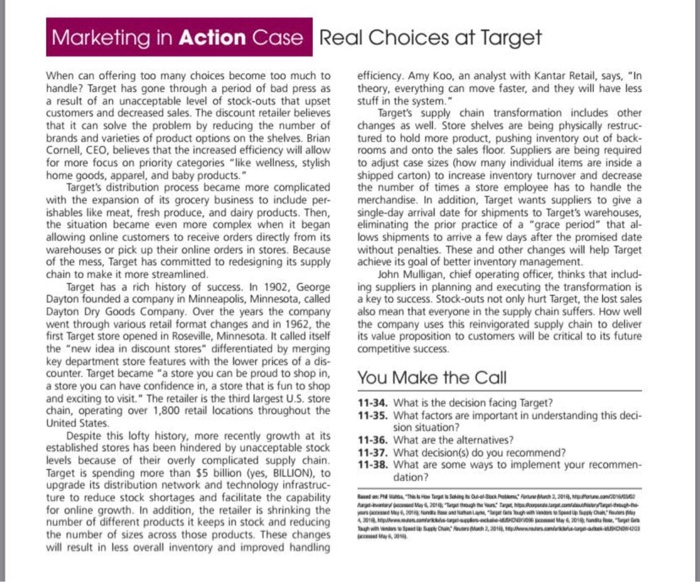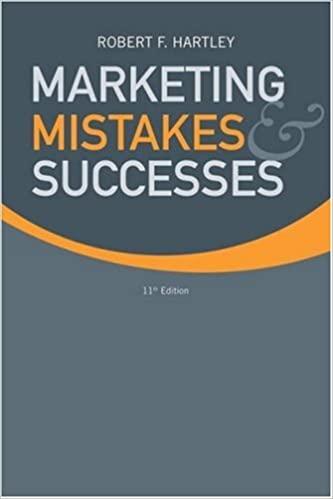......MARKETING1
1.
Case Study: Marketing in Practice Know Your Limit The career management centre at the Sprott School of Business at Carlton University had just posted the listing of students who had received an internship interview opportunity with the Ontario Lottery and Gaming Corporation (OLG), and Kirk Kristofferson was thrilled to see his name on the list. Finishing off his third year of study in the Marketing option, Kirk was eager to get some real-world experience. and the OLG had seemed like a reasonable place to apply. Kirk knew that he would have to put some time in to prepare effectively for the interview. He needed to do research on the organization, gaming Itself, and the specifics of the internship opportunity-an analyst position in the responsible gaming division of the organization. Kirk wasn't really a gambler and had rarely played the lottery, bet on sports, or visited a casino. In fact, he was a bit unclear on where he stood with respect to the notion of government-sponsored gaming. Kirk knew that gambling was a morally sensitive topic to some people. and he realized his research for this opportunity would help him define his attitudes toward both the company and the gaming products it provided the public. Ontario Lottery and Gaming Corporation Ontario Lottery and Gaming Corporation The OLG is an agency created by the Government of Ontario that is responsible for 24 gaming sites and sales of lottery products at over 10 000 retail locations across the province. Its central mission is to make life better for people across Ontario. This is accomplished in a number of ways. Foremost, the gaming activities of the OLG produce revenues that go directly to the government and nonprofit organizations and are used to support health care, sports and recreation, and cultural programs. Further, OLG operations generate substantial employment and economic benefits in the host communities where their operations are located. Finally, the OLG provides a distinct form of entertainment that certain segments of the population enjoy and find value in. Importantly, since 1975, lotteries and casinos have generated more than $28 billion for the benefit of the citizens of Ontario. The OLG was the product of the merger of lottery and casino operations in the province in the year 2000. Since that point in time, the corporation has managed and developed a number of products and brands that broadly cover all aspects of gaming in the province. Lottery brands include traditional brands (e.g., Lotto Max, Lotto 6/49, and Ontario 49), instant scratch-and-win tickets, specialty games (e.g., Keno), and sports betting (e.g., Pro-Line and Pro-Picks), Casinos (e-g., Brantford, Great Blue Heron Casino) and slot operations at 14 racetracks across the province represent the other central aspect of OLG business. The OLG has identified four priorities that underlie the management goals of the organization: public trust (facilitating trust through integrity of their operations), player experience (providing entertaining gaming), partnership (being active partners in the communities where they operate), and profits (returning significant dividends to support public initiatives).Know Your Limit; Play within It Though the OLG is a Crown corporation controlled by the Government of Ontario, it hasn't escaped strong criticism from interest groups concerned with the negative impacts that gaming can create for individuals and communities. Indeed, critics of legalized gambling generally denounce gaming for causing harm to society. Harm here is typically discussed in terms of the regressive nature of gaming as an implicit tax on those lower in socioeconomic status, the fostering of illegal activities that gambling provides, such as the potential for fraud and money laundering, and, perhaps most concerning, the societal toll that problem gamblers can take on families and their communities (e.g, divorce, bankruptcy, lost productivity). Given these concerns, the OLG is strongly committed to finding the appropriate balance between profitability and social responsibility. Specific values of the organization centre on integrity, respect, and accountability, and through the "Know Your Limit, Play within It" initiative, the organization makes an effort to ensure that players understand how the games work and recognize their own gambling behaviours. For those with possible gambling problems, the OLG tries to ensure that players know where and when to get help. Working in partnership with government and independent agencies, the corporation provides information and tools in the prevention of problem gaming, and helps players make informed decisions when playing. Interview Preparation Kirk was intrigued after reviewing the history, background, and current operations of the OLG. He hadn't realized how big an operation it managed, and how central the company had become to the revenue model of the provincial government. The organization would certainly provide a great experience over the summer, and exposure to all aspects of the business function. However, Kirk couldn't quite resolve the uncomfortable feelings he had about working in an industry that created significant problems for a specific segment of the population. He did admire the efforts the OLG had made with respect to responsible gaming, but he knew that this effort didn't completely resolve the problems gambling created. Further, he wondered if the company was truly sincere in its efforts. He had read reports online that casinos didn't really enforce the outlined regulations and policies concerning underage players and those with addiction problems. What was the real story on responsible gaming? Kirk imagined he should ask questions in the interview regarding the success and failures of the company in this regard. He wondered if working directly in that business unit would alleviate his fears, or if it would only magnify his concerns. Preparing for the interview had certainly raised Kirk's awareness and curiosity with respect to the OLG and its role in the community. 1. What types of questions would you ask the OLG if you were interviewing for an internship? Would it make a difference to you if the internship was in casino operations or in responsible gaming? Why?2. Some argue that gambling is a dark consumer behaviour due to the negative impact of this behaviour on some segments of the population. Do you agree or disagree? Why? 3. Whose responsibility is it to regulate gambling behaviours? The consumer? The government? Somebody else? 4. Provincial governments across Canada have become dependent on gaming revenues to fund government programs. Do you see this as problematic? Why? What responsibilities does government have in mitigating the negative outcomes that surround gaming?Marketing in Action Case Real Choices at Target When can offering too many choices become too much to efficiency. Amy Koo, an analyst with Kantar Retail, says, "In handle? Target has gone through a period of bad press as theory, everything can move faster, and they will have less a result of an unacceptable level of stock-outs that upset stuff in the system." customers and decreased sales. The discount retailer believes Target's supply chain transformation includes other that it can solve the problem by reducing the number of changes as well. Store shelves are being physically restruc brands and varieties of product options on the shelves. Brian tured to hold more product, pushing inventory out of back- Cornell, CEO, believes that the increased efficiency will allow rooms and onto the sales floor. Suppliers are being required for more focus on priority categories "like wellness, stylish to adjust case sizes (how many individual items are inside a home goods, apparel, and baby products." shipped carton) to increase inventory turnover and decrease Target's distribution process became more complicated the number of times a store employee has to handle the with the expansion of its grocery business to include per- merchandise. In addition, Target wants suppliers to give a ishables like meat, fresh produce, and dairy products. Then, single-day arrival date for shipments to Target's warehouses, the situation became even more complex when it began eliminating the prior practice of a "grace period" that al- allowing online customers to receive orders directly from its lows shipments to arrive a few days after the promised date warehouses or pick up their online orders in stores. Because without penalties. These and other changes will help Target of the mess, Target has committed to redesigning its supply achieve its goal of better inventory management. chain to make it more streamlined. John Mulligan, chief operating officer, thinks that include Target has a rich history of success. In 1902, George ing suppliers in planning and executing the transformation is Dayton founded a company in Minneapolis, Minnesota, called a key to success. Stock-outs not only hurt Target, the lost sales Dayton Dry Goods Company. Over the years the company also mean that everyone in the supply chain suffers. How well went through various retail format changes and in 1962, the the company uses this reinvigorated supply chain to deliver first Target store opened in Roseville, Minnesota. It called itself its value proposition to customers will be critical to its future the "new idea in discount stores" differentiated by merging competitive success. key department store features with the lower prices of a dis- counter. Target became "a store you can be proud to shop in, a store you can have confidence in, a store that is fun to shop You Make the Call and exciting to visit. " The retailer is the third largest U.S. store 11-34. What is the decision facing Target? chain, operating over 1,800 retail locations throughout the United States. 11-35. What factors are important in understanding this deci- sion situation? Despite this lofty history, more recently growth at its established stores has been hindered by unacceptable stock 11-36. What are the alternatives? levels because of their overly complicated supply chain 11-37. What decision(s) do you recommend? 11-38. What are some ways to implement your recommen Target is spending more than $5 billion (yes, BILLION), to dation? upgrade its distribution network and technology infrastruc ture to reduce stock shortages and facilitate the capability for online growth. In addition, the retailer is shrinking the number of different products it keeps in stock and reducing the number of sizes across those products. These changes will result in less overall inventory and improved handling










